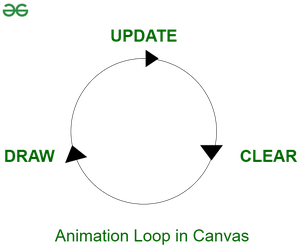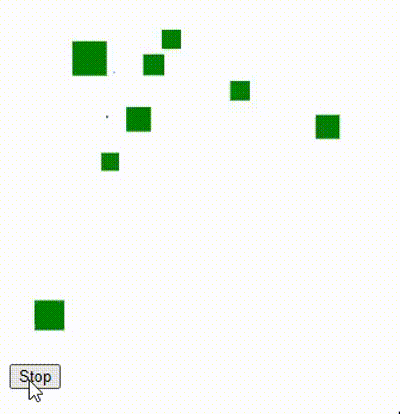En este artículo, aprenderemos cómo crear animaciones dinámicas en nuestra página web utilizando los elementos de lienzo en HTML5. El objetivo principal de este elemento es crear gráficos desde cero o manipularlos . Se puede utilizar para manipular el lienzo mediante la API de JavaScript y crear animaciones y gráficos dinámicos que reaccionan a la interacción del usuario. La interfaz de usuario para aplicaciones web también se puede construir usándola.
Sintaxis:
<canvas id="myCanvas" width="500" height="500">
...
</canvas>
Podemos lograr una animación dinámica en HTML siguiendo los siguientes pasos uno a la vez:
Paso 1: Creación de bucle de animación:
let canvas = $("#myCanvas");
// Rendering 2-D canvas on webpage
let context = canvas.get(0).getContext("2d");
let Width = canvas.width();
let Height = canvas.height();
function animate() {
// Creates endless loop by calling animate
// function again in 35 milliseconds
setTimeout(animate, 35);
};
animate(); // Calling the function animate

Paso 2: Lógica para manejar los botones para interactuar con la animación:
let playAnimation = true;
let startButton = $("#start");
let stopButton = $("#stop");
startButton.hide(); // Disabled Start button
startButton.click(() => {
$(this).hide();
stopButton.show();
playAnimation = true;
animate();
});
stopButton.click(() => {
$(this).hide();
startButton.show();
playAnimation = false;
});
Paso 3: Seleccionar y aleatorizar formas:
let Shape = function (x, y, width, height) {
this.x = x;
// Define starting position of the shape
this.y = y;
// Define height and width of the shape
this.width = width;
this.height = height;
};
// To randomize the position and size of each shape
for (let i = 0; i < 5; i++) {
let x = Math.random() * 200;
let y = Math.random() * 200;
let width = height = Math.random() * 50;
shapes.push(new Shape(x, y, width, height));
};
context.fillRect(tmpShape.x, tmpShape.y,
tmpShape.width, tmpShape.height);
Paso 4: Cambiar de dirección:
tmpShape.x += 2; // Increment x co-ordinate by 2 tmpShape.y + // Increment y co-ordinate by 1 // For unpredictable patterns tmpShape.x += Math.random() * 3 + 2; tmpShape.y += Math.random() * 3 - 1;
Los cuatro pasos anteriores constituyen la estructura básica para crear animaciones dinámicas en lienzo. De acuerdo con el requisito de animación requerido, necesitamos construir lógica y codificar la lógica en la función animate() . A continuación se muestra un ejemplo de rebote de objetos fuera de un límite de lienzo .
Ejemplo: Este es el ejemplo completo que ilustrará cómo dibujar animaciones dinámicas en HTML5.
HTML
<!DOCTYPE html>
<html>
<head>
<title>How to Build Dynamic Graphics in HTML5</title>
<script type="text/javascript" src=
"http://ajax.googleapis.com/ajax/libs/jquery/1/jquery.min.js">
</script>
</head>
<body>
<canvas width="300" height="300" id="Canvas">
</canvas>
<!-- Buttons to control the animation loop -->
<div>
<button id="start">Start</button>
<button id="stop">Stop</button>
</div>
<script>
let canvas = $("#Canvas");
let context = canvas.get(0).getContext("2d");
context.fillStyle = "green";
// Width of the animation
let Width = canvas.width();
// Height of the animation
let Height = canvas.height();
let playAnimation = true;
let startButton = $("#start");
let stopButton = $("#stop");
// Code to disable Start button
startButton.hide();
startButton.click(function () {
$(this).hide();
stopButton.show();
playAnimation = true;
animate();
});
// Code to disable Stop button
stopButton.click(function () {
$(this).hide();
startButton.show();
playAnimation = false;
});
// Code to define width and height of the shape
let Shape = function (x, y, width, height) {
this.x = x;
this.y = y;
this.width = width;
this.height = height;
// No reversal of direction in
// the x-axis initially
this.reverseX = false;
this.reverseY = false;
};
// Code to generate ten random
// shapes for animation loop
let shapes = new Array();
for (let i = 0; i < 10; i++) {
let x = Math.random() * 300;
let y = Math.random() * 300;
let width = height = Math.random() * 30;
// Adding random shapes to canvas
shapes.push(new Shape(x, y, width, height));
};
function animate() {
context.clearRect(0, 0, Width, Height);
let shapesLength = shapes.length;
for (let i = 0; i < shapesLength; i++) {
let tmpshape = shapes[i];
if (!tmpshape.reverseX) {
// Increment the x co-ordinate by 3 units
tmpshape.x += 3;
} else {
// Decrement the x co-ordinate by 3 units
tmpshape.x -= 3;
};
if (!tmpshape.reverseY) {
// Increment the y co-ordinate by 3 units
tmpshape.y += 3;
} else {
// Decrement the y co-ordinate by 3 units
tmpshape.y -= 3;
};
// Code for shapes to bounce off the boundary
context.fillRect(tmpshape.x, tmpshape.y,
tmpshape.width, tmpshape.height);
if (tmpshape.x < 0) {
tmpshape.reverseX = false;
} else if (tmpshape.x + tmpshape.width > Width) {
// Reverse the direction of shape if position of
// shape is greater than width of canvas
tmpshape.reverseX = true;
};
if (tmpshape.y < 0) {
tmpshape.reverseY = false;
} else if (tmpshape.y + tmpshape.height > Height) {
// Reverse the direction of shape if position of
// shape is greater than height of canvas
tmpshape.reverseY = true;
};
};
if (playAnimation) {
setTimeout(animate, 35);
}; // Runs animate() function infinitely
// after every 35ms
};
animate();
</script>
</body>
</html>
Producción:

Hacer rebotar objetos en un límite del lienzo
Navegadores compatibles:
- Google Chrome
- explorador de Internet
- Firefox
- Ópera
- Safari
Publicación traducida automáticamente
Artículo escrito por priddheshinternship y traducido por Barcelona Geeks. The original can be accessed here. Licence: CCBY-SA